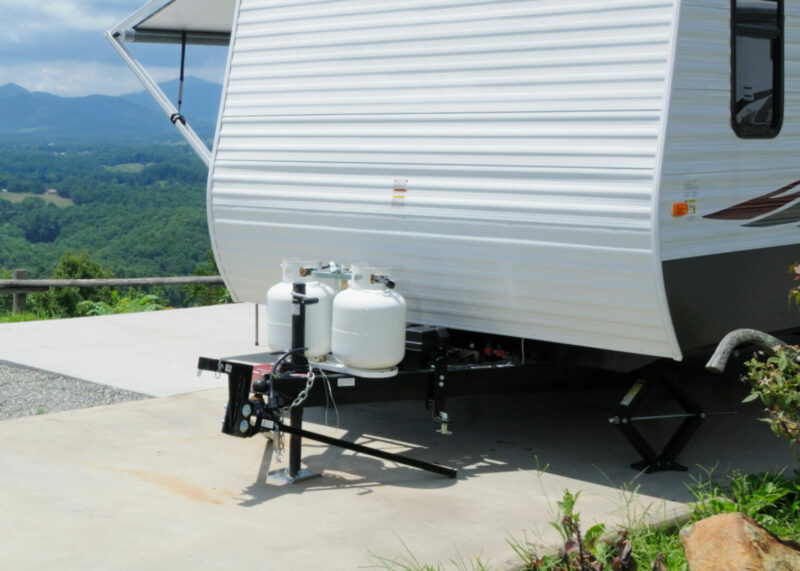Table of Contents Show
You might have seen a Grand Design Imagine travel trailer with two RV propane tanks attached to the tongue. And then you walk down a few campsites and see a Forest River Sabre fifth wheel without any propane tanks.
Where are they? Are they different from the propane tanks on the Imagine? And what about those huge Class A motorhomes? Where are the propane tanks on a Tiffin or Thor?
We wanted to address any confusion surrounding your RV propane tank. It’s essential to the proper function of all RVs, but there are differences. Let’s explore the world of RV propane tanks!
Are RV Propane Tanks Different?
Not all RV propane tanks are the same size, nor are they all portable. Motorhomes usually have permanently-affixed ASME propane tanks, whereas travel trailers and fifth wheels have onboard portable DOT cylinders.
So there are differences, and knowing the differences will help you best use and maintain your RV propane tanks.
Pro Tip: Your RV propane system is one of the most important but least understood parts of your rig. Learn how your propane system works today.
RV Propane Tank Sizes
Depending on the size of your RV, the propane tank size will vary. Larger fifth wheels may have a couple of 30 lb tanks. On the other hand, smaller travel trailers will have a couple of 20 lb tanks onboard.
A 20 lb RV propane tank will hold approximately 4.5-4.7 gallons of propane, and a 30 lb tank will hold approximately seven gallons of propane. These numbers represent about 80% of the tank’s capacity, as the extra 20% is reserved for fuel expansion.
ASME tanks on Class A motorhomes are much larger. Some are 80 lbs, and others are 100 lbs. Obviously, these tanks will operate the RV systems for much longer than the 20 lb or 30 lb DOT cylinders. Smaller Class C motorhomes may come with a smaller 20 lb ASME propane tank.
Are RV Propane Tanks Interchangeable?
You can swap out a smaller 20 lb RV propane tank for a larger 30 lb or 40 lb container (or the reverse). However, there are a few things to consider.
First, a large one will weigh more. If you have 20 lb propane tanks sitting on the tongue of your travel trailer, you’ll be adding weight if you swap them out for a larger size. If you’re already close to your max weight, this could be a problem.
Second, will they fit? The new tanks might be too large for the propane stands, or the connections might be different sizes. Additionally, Many travel trailers have covers over the propane tanks, which may not fit if you change out 20 lb cylinders for a larger size.
Also, fifth wheels have their propane tanks stored in the outdoor storage bays. If the compartment was designed for a 20 lb tank, a 30-lb tank might not fit there.

External vs Onboard RV Propane Tanks
The terms “external” and “onboard” refer to the location of the propane tank. External propane tanks are built into the frame of an RV. An onboard tank refers to those that sit on the tongue of a travel trailer or in the outdoor storage bay of a fifth wheel. It does not refer to propane tanks stored inside your RV, as you should never store propane in your living or passenger spaces!
You’ll see onboard RV propane tanks on travel trailer tongues with a cover over them. Fifth wheels don’t have a tongue, so the propane tanks will be in the outdoor storage bays. You must always transport DOT cylinders uprightly, so take precautions to prevent them from tipping over.
The ASME propane tanks are usually fixed to the undercarriage of Class A and Class C motorhomes. Because they’re part of your RV’s frame, you won’t have to worry about them tipping over or replacing them. They’re also very heavy duty, so the risk of them puncturing in low-clearance situations is slim.
Pro Tip: Learn how to hookup external propane tanks so you don’t have to move your RV every time you need more gas.
Can You Use a BBQ Propane Tank on Your RV?
You can certainly use a BBQ propane tank on your RV as long as it’s the right size. Most BBQ grills that people own at a sticks-and-bricks house operate using a 20-lb propane tank. These are the same propane tanks travel trailers and some fifth wheels use, so it’s entirely safe to interchange them. Many RVers will use their onboard propane tanks to fuel their gas grills when they cook outdoors, too.

ASME vs DOT
ASME propane tanks are permanently installed on motorhomes and approved by the American Society of Mechanical Engineers. Manufacturers bolt these tanks underneath Class A and Class C motorhomes.
DOT cylinders are removable and sit on the outside of a travel trailer or fifth wheel. They get their name because the Department of Transportation approves them. Usually, travel trailers will have DOT cylinders on the tongue of the camper, while fifth wheels have exterior compartments that hold the cylinders.
ASME tanks are quite heavy because they’re thick steel. DOT cylinders are portable, so they’re more lightweight. That way, you can remove them and take them to a refill station easily.
Although both RV propane tanks require regular maintenance, DOT cylinders require recertification twelve years after manufacture.
Where to Refill RV Propane Tanks
Many campgrounds and gas stations offer propane refill stations. Wholesale stores like Costco also offer this service. Check the area where you are staying to locate propane refill stations.
You don’t want to be caught without propane on a cold night and nowhere to refill until the next morning. So always keep an eye on your propane tanks and know how much you’re using. It’s an easy process to refill the tanks, but you don’t want to wait until too late.
Where to Exchange Portable Propane Tanks
Most gas stations, grocery stores, wholesale stores, and even dollar stores will have propane tanks if you want to exchange yours instead of refilling it. Whether or not you choose to refill or exchange your propane tanks, always close the valves and disconnect the pigtail hose from the tank.
We also want to stress this point again: Transport your portable propane tanks upright in your vehicle. Don’t let them roll around in the trunk or lie sideways.
Do RV Propane Tanks Have to Be Recertified?
DOT cylinders have to be recertified twelve years after the manufacture date. Some people choose to exchange their propane tanks as they near the recertification date. Whenever you exchange your DOT cylinders, check the manufacture date. You don’t want to receive a tank that’s close to the twelve-year mark to avoid recertification.
If you choose to go through the recertification process, it’s fairly simple and easy. You must take your RV propane tank to a certified retailer, where an inspector will look over the container for rust or dents and conduct a leak test. Most people would prefer not to pay the recertification fee and instead go the cheaper route of exchanging their propane tanks.
Now You Know!
So that’s why you might see portable DOT propane tanks on the tongue of a travel trailer and not on the outside of a fifth wheel at a campground. You won’t find any tanks sitting around a Class A or Class C motorhome, either.
Know what kind and size of RV propane tank you have, understand the proper maintenance, and use them appropriately to ensure a safe and enjoyable camping experience.
Do you know what kind of propane tanks are on your RV?






